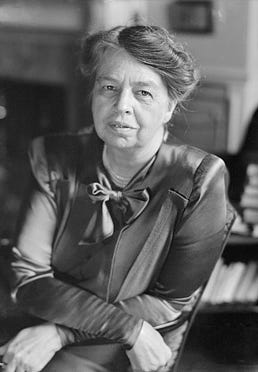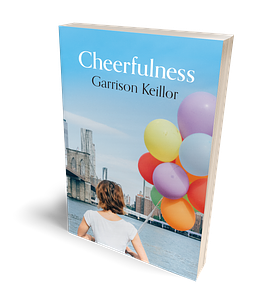|
 |
The Writer's Almanac from Wednesday, October 11, 2017
“The Book of Usable Minutes” by Sally Van Doren from Promise. © Louisiana State University Press, 2017.
ORIGINAL TEXT AND AUDIO - 2017
It's the birthday of the longest-serving First Lady, Eleanor Roosevelt, born in New York City (1884) who said, "A woman is like a tea bag. You never know how strong she is until she gets into hot water." She began a secret courtship with her cousin Franklin Delano Roosevelt. During World War I, she went off to Europe and visited wounded and shell-shocked soldiers in hospitals there. Later, during her husband's presidency, she campaigned hard on civil rights issues — not a universally popular thing in the 1930s and 1940s.
After FDR died in 1945, she moved from the White House to Hyde Park, New York, and taught International Relations at Brandeis University. As anti-communist witch-hunting began to sweep the U.S., she stuck up for freedom of association in a way that few Americans were brave or bold enough to do. She chided Hollywood producers for being so "chicken-hearted about speaking up for the freedom of their industry." She said that the "American public is capable of doing its own censoring" and that "the judge who decides whether what [the film industry] does is good or bad is the man or woman who attends the movies."
She said that the Un-American Activities Committee was creating the atmosphere of a police state in America, "where people close doors before they state what they think or look over their shoulders apprehensively before they express an opinion."
In 1947, a couple years before the McCarthy Era had reached full swing, she announced, "The Un-American Activities Committee seems to me to be better for a police state than for the USA."
She once said, "We have to face the fact that either all of us are going to die together or we are going to learn to live together and if we are to live together we have to talk."
And, "You wouldn't worry so much about what others think of you if you realized how seldom they do."
It's the birthday of physicist and psychologist Lewis Fry Richardson, born in Northumberland, England (1881), who was the first to apply mathematical techniques to predict the weather accurately. During WWI, Richardson served as a driver for the Friends' Ambulance Unit in France. During the intervals between transporting wounded soldiers from the front, he manually computed the changes in pressure and wind at two points. From this information, he wrote his 1922 book, Weather Prediction by Numerical Process. The problem with his theories was that it took him about three months to predict the weather for the next 24 hours. His system did not become practical until the advent of electronic computers after World War II.
It's the birthday of Mason Locke Weems, born in Anne Arundel County, Maryland (1759). He was an Episcopalian clergyman and a traveling bookseller. He wrote extremely popular fictional tales about history and presented them as if they were fact.
Weems traveled around in a Jersey wagon on dusty rural roads for more than 30 years, peddling books and playing the fiddle during the long rides. He had long curls and wore a clerical coat with a quill pen stuck in his hat and an inkhorn hanging from his lapel.
It was Weems who invented the famous story about George Washington cutting down his father's cherry tree with a hatchet, and then admitting that it was made-up. Weems included that story in his mostly fictional biography The Life and Memorable Actions of George Washington (1800).
Washington's biography wasn't the only one in which Weems took liberties with the truth. He also wrote about Francis Marion, a military officer who served in the American Revolutionary War. Using the work of Marion's friend, General Peter Horry, he set about writing a book. Horry was shocked with the result. He wrote Weems, "I requested you would so far alter the work as to make it read grammatically, but entertained not the least idea of what has happened…You have carved and mutilated it with so many erroneous statements [that] your embellishments, observation and remarks, must necessarily be erroneous as proceeding from false grounds…Can you suppose I can be pleased with reading particulars of Marion and myself, when I know such never existed?"
But the public loved Weems' works. The Life of Washington, for decades, outsold every book in the United States except the Bible.
Pope John XXIII convened the first session of the Second Vatican Council on this date in 1962. It was the first time Roman Catholic religious leaders had met to settle doctrinal issues in nearly a century. In 1870, the pope had been declared infallible, so people didn't see the point of arguing about church doctrine: whatever the pope said was what the church would do and believe. But Pope John XXIII — who had assumed his duties only three months prior to calling for the council — believed that the church had become too insular for modern times. He often said it was time to "open the windows [of the church] and let in some fresh air." He had served in the Italian army during World War I, then served as a Vatican diplomat to Turkey, Greece, and Bulgaria for nearly 20 years. During the Second World War, he was a papal ambassador in Paris. He had witnessed the whole spectrum of human nature and religious faith during those appointments, and believed that the church should not hold itself separate from the rest of the world.
Thousands of church members — from bishops down to laypeople — traveled to St. Peter's Basilica in Vatican City to attend a series of four sessions from 1962 to 1965. Representatives from other Christian denominations were invited to observe, although they couldn't cast any votes. The council produced 16 documents, and the common thread running through them was "reconciliation." The pope still had the last word, but other voices would now be heard, even encouraged. The Roman Catholic Church would now allow Mass to be celebrated in languages other than Latin. Priests now faced the congregation, not the altar, so that worshippers would feel more a part of the service. They also gradually set aside their ornate clerical regalia and dressed more simply. Some liturgical music was updated to a more contemporary style. As Thomas Ryan, director of the Loyola Institute for Ministry, put it: "Not against, not above, not apart, but in the modern world. The church sought to engage, not condemn."
One of the most revolutionary aspects of Vatican II — as the Second Vatican Council came to be known — was the change in the church's attitude toward other religions, and other Christian denominations. Previously, Catholics were forbidden from visiting any other houses of worship, and encouraged to look down on other religions. Now they could attend the weddings, bar mitzvahs, and funerals of their non-Catholic friends and neighbors. The church also acknowledged its shared history with Judaism for the first time. Before Vatican II, the Jews were viewed with suspicion and stigmatized as the killers of Jesus Christ. "It had the effect that the sun has when it comes up and interrupts the night," said Rabbi Edward Cohn of New Orleans' Temple Sinai. "It was no less dramatic than that. It provided an entirely new day. It changed everything."
Not all the policies proposed by the Second Vatican Council were carried out perfectly, or carried out at all in some cases. Many church bureaucrats resisted the changes, and traditionalist Catholics still argue that Vatican II was detrimental to the church. Even mythologist Joseph Campbell, a lapsed Catholic, mourned the loss of religious mystery: "They've translated the Mass out of ritual language and into a language that has a lot of domestic associations. The Latin of the Mass was a language that threw you out of the field of domesticity. The altar was turned so that the priest's back was to you, and with him you addressed yourself outward. Now they've turned the altar around — it looks like Julia Child giving a demonstration — all homey and cozy. … They play a guitar. They've forgotten that the function of ritual is to pitch you out, not to wrap you back in where you have been all the time." But the opening up of the Mass to different languages has led to a dramatic expansion of the Roman Catholic Church in Africa and Asia.
It's the birthday of novelist Elmore Leonard, born in New Orleans in 1925. Straight out of college he got a job at an advertising agency, so he would get up and write every morning at 5 a.m. before going into the office. He published some pulp Westerns, and then started writing crime fiction, and went on to write more than 40 books. Many of them have been turned into movies, including his novels Get Shorty (1990), Be Cool (1999), and Rum Punch (1992), which Quentin Tarantino made into the film Jackie Brown.
He gave 10 rules on writing, things like "Never open a book with weather," "Never use a verb other than 'said' to carry dialogue," "Avoid detailed descriptions of characters," and "Try to leave out the parts that readers tend to skip." He wrote: "Think of what you skip reading a novel: thick paragraphs of prose you can see have too many words in them. What the writer is doing, he's writing, perpetrating hooptedoodle, perhaps taking another shot at the weather, or has gone into the character's head, and the reader either knows what the guy's thinking or doesn't care. I'll bet you don't skip dialogue. My most important rule is one that sums up the 10. If it sounds like writing, I rewrite it."
To get inside the heads of the despicable people he writes about, Leonard said: "I [try] to put myself in [a criminal's] place. He doesn't think he's doing an evil thing. I try to see [him] at another time — when he sneezes, say. I see convicts sitting around talking about a baseball game. I see them as kids. All villains have mothers."
When asked why he writes about criminals, instead of ordinary people, Leonard said, "I just feel more secure in a situation where I know a gun can go off at any time if things get boring."
Be well, do good work, and keep in touch.®
CLICK HERE to order Cheerfulness by Garrison Keillor.
You’re a free subscriber to The Writer's Almanac with Garrison Keillor. Your financial support is used to maintain these newsletters, websites, and archive. Support can be made through our garrisonkeillor.com store, by check to Prairie Home Productions P.O. Box 2090, Minneapolis, MN 55402, or by clicking the SUBSCRIBE button. This financial support is not tax deductible.


